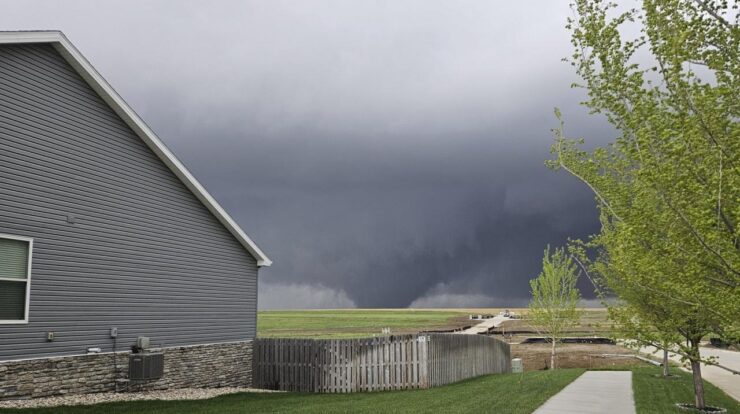
Tornado Damage in Nebraska: A Comprehensive Overview
Tornadoes, with their destructive force, have left an indelible mark on the landscape of Nebraska. This article delves into the assessment, impacts, and recovery efforts associated with these devastating weather events in the state.
1. Tornado Damage Assessment
Tornado damage assessment in Nebraska involves a comprehensive process to evaluate the severity and extent of damage caused by tornadoes. The National Weather Service (NWS) utilizes various methods to assess tornado damage, including:
- Aerial surveys: Using aircraft or drones to capture aerial footage and photographs of affected areas.
- Ground surveys: Conducting on-site inspections by trained meteorologists and engineers to examine damage firsthand.
- Damage assessment teams: Deploying specialized teams to conduct detailed assessments of buildings, infrastructure, and other affected areas.
The NWS uses the Enhanced Fujita Scale (EF Scale) to measure tornado intensity, which ranges from EF0 to EF5. The EF Scale is based on wind speeds and the type and extent of damage observed. Nebraska has experienced tornadoes of all intensities, with EF5 tornadoes being the most destructive.
Tornado damage is categorized and documented using a variety of methods, including:
- Damage surveys: NWS teams conduct detailed surveys to assess the extent and severity of damage, assigning EF ratings based on the observed damage.
- Damage reports: Local authorities, emergency responders, and the public submit damage reports to the NWS, providing information on the location, type, and severity of damage.
- Aerial photography: Aerial images and footage captured during and after tornadoes provide valuable data for damage assessment and documentation.
2. Historical Tornado Events in Nebraska
Nebraska has a long history of significant tornado events, with some of the most notable occurring in recent decades:
- 1950 Grand Island tornado: An F5 tornado struck Grand Island, causing widespread destruction and killing five people.
- 1975 Omaha tornado outbreak: A series of tornadoes, including an F4 tornado, hit the Omaha metropolitan area, resulting in two deaths and significant damage.
- 2004 Hallam tornado: An EF4 tornado devastated the town of Hallam, killing one person and causing extensive damage to buildings and infrastructure.
- 2019 Pilger tornado: An EF4 tornado struck the town of Pilger, destroying numerous homes and businesses.
- 2023 Norfolk tornado: An EF4 tornado caused widespread damage in Norfolk, including the destruction of a grain elevator and several homes.
The regions of Nebraska most prone to tornado activity include the eastern and central parts of the state, which are located in Tornado Alley. These areas experience frequent thunderstorms during the spring and summer months, which can produce tornadoes.
The formation of tornadoes in Nebraska is influenced by several factors, including:
- Warm, moist air: The warm, humid air from the Gulf of Mexico provides the energy needed for tornado formation.
- Dry line: A boundary between moist and dry air can create an updraft, which can lead to tornado formation.
- Jet stream: The jet stream, a high-altitude wind current, can provide the wind shear necessary for tornado development.
3. Impact of Tornado Damage on Nebraska’s Infrastructure

Tornado damage can have a devastating impact on Nebraska’s infrastructure, including buildings, roads, and bridges:
- Buildings: Tornadoes can cause severe damage to buildings, ranging from minor roof damage to complete destruction. Commercial buildings, residential homes, and public structures can all be affected.
- Roads: Tornadoes can damage roads, making them impassable. This can disrupt transportation and emergency response efforts.
- Bridges: Tornadoes can also damage or destroy bridges, cutting off access to certain areas and affecting transportation.
Communities face significant challenges in repairing and rebuilding after a tornado:
- Cost: The cost of repairing and rebuilding infrastructure can be substantial, putting a strain on local budgets.
- Time: Repairing and rebuilding infrastructure can take a long time, especially if there is extensive damage.
- Displacement: Residents and businesses may be displaced from their homes or workplaces while repairs are underway.
To enhance infrastructure resilience to tornadoes, communities are implementing innovative approaches, such as:
- Tornado-resistant construction: Building codes and standards are being updated to require new buildings to be more resistant to tornado damage.
- Retrofitting: Existing buildings are being retrofitted with tornado-resistant features, such as reinforced walls and roofs.
- Emergency shelters: Communities are building or upgrading emergency shelters to provide safe havens for residents during tornadoes.
Summary
Understanding tornado damage in Nebraska is crucial for enhancing preparedness, mitigating impacts, and fostering resilience. Through comprehensive assessment, proactive safety measures, and collaborative recovery efforts, Nebraska strives to minimize the devastation caused by these powerful storms.
Expert Answers: Tornado Damage In Nebraska
How is tornado damage assessed in Nebraska?
Nebraska utilizes various methods to assess tornado damage, including the Enhanced Fujita Scale (EF Scale) to measure intensity and detailed documentation of structural damage.
What are the most tornado-prone regions in Nebraska?
The eastern and central regions of Nebraska, known as Tornado Alley, experience the highest frequency and intensity of tornadoes.
How does Nebraska promote tornado safety?
Nebraska implements a comprehensive tornado safety plan, including early warning systems, evacuation drills, and public education campaigns.




